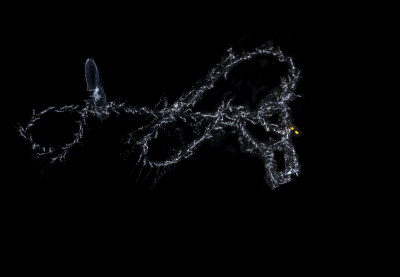
Siphonophor Sulculeolaria chuni (suborder Calycophorae), photo by Maciej Mańko
Their larvae are the size of an ant, but over time they surpass even whales in length - siphonophores are the subject of a scientific project by dr Maciej Mańko from the Faculty of Oceanography and Geography. The young oceanographer's research proposal was judged to be the best in the call for applications to the Bekker NAWA programme, which supports the international mobility of researchers. In the autumn of this year, dr Maciej Mańko will travel to Yale University, where he will explore the mysteries of siphonophores fragmentation together with world-class specialists.
Marcel Jakubowski: - The siphonophores are astonishing at their very core. Could you briefly tell us what these creatures are?
Dr Maciej Mańko: - Siphonophores are colonial cnidarians, close cousins of jellyfish. Their structure is that they are a whole colony of interconnected individual organisms, each with a different function. Some elements are used for locomotion, others for food collection, and yet others have reproductive functions.
- How does such a structure differ from that of, say, a human being, whose organism also has elements with different functions?
- To answer this question, we need to go back to how these creatures are formed. Siphonophores begin their life as a small larva 0.5 mm long, a so-called planula, which drifts through the ocean. This small structure then begins to bud other members to form a colony. The adult siphonophore has a linear colony - it takes the form of a long line in which budding proceeds continuously, that is, new elements are added all the time. It is a bit like having more arms, legs, or other organs continually growing out of your neck. Importantly, each species of siphonophores has a very specific sequence of adding new elements to the colony.
- Is there a limit to their development? As long as they have the right conditions, will they continue to grow indefinitely?
- That is what we do not know. This is one of the key questions, alongside the question of how long siphonophores live. The record holders are over 40 metres, so they definitely win the title of the longest invertebrates in the ocean.

dr Maciej Mańko, photo by Marcel Jakubowski
- As part of a project funded by the Bekker Programme of the National Academic Exchange Agency, you will study the fragmentation of these creatures, i.e. the separation of parts of the colony. How does this fragmentation occur and what happens to these siphonophores’ fragments afterwards?
- I started to take an interest in this question already in a previous project, funded by the Prelude programme of the National Science Centre. In it, I studied the very precise fragmentation occurring only in certain siphonophores. These species were deciding for themselves that they wanted to cut off part of themselves. They were separating the final fragment of the colony with elements for swimming, food acquisition, and, above all, reproductive functions. Such a fragment drifted into the ocean and then reproduced away from the parent colony.
- Can siphonophores be divided by something else than their own will?
- Within the framework of Bekker's scholarship, I will look into the fragmentation of the longest siphonophores, which, to our knowledge, do not divide of their own accord. On the other hand, it may happen that a fish enters such a colony and the colony breaks up into smaller pieces. These fragments are able to survive hundreds and thousands of metres underwater in deep water. They have excellent buoyancy, so they will neither sink to the bottom nor be brought to the surface. They can reproduce and forage for food. In the project, we want to test whether this opportunistic ability to fragment affects how the population genetics of these animals are shaped. That is, whether populations living in different parts of the ocean connect via these fragments. We assume that a siphonophore fragment can drift for a very long time with ocean currents, even to the other end of the ocean - and then reproduce with a second population.
- Such a siphonophore is not able to move consciously, it just swims with the sea currents. What are the chances that in the vastness of the ocean, it will come across another representative of its species?
- This is a great question to which we do not know the definitive answer. Smaller siphonophores are able to swim in the direction of their choice and make diurnal vertical migrations linked to the solar cycle. This means that they swim towards the surface in the evening and plunge into deeper water at dawn. However, in larger siphonophores, the part responsible for swimming is only about 0.1% of the length of their colony. There is no way that something so small could pull off an entire colony. We therefore assume that they move passively in the water.
- Are there any hypotheses on how they manage to reproduce?
- We still have siphonophores in the world, so this reproductive success is occurring. A clue here could be, for example, the synchronicity of reproduction. Such a phenomenon is well documented in corals. All individuals of a species release gametes into the ocean at the same time. They usually synchronise this with the phases of the moon. In this way, they reduce the risk of the released gametes dying in the depths of the water and increase the chance of fertilisation. Perhaps something like this also occurs in siphonophores; they are, after all, close cousins of corals.
- When you say siphonophores, do you mean all their suborders?
- In classical taxonomy, there are three suborders of siphonophores, they are called Cystonectae, Physonectae, and Calycophorae. These names distinguish the siphonophores according to the colony structure. In the Cystonectae, the elements for swimming, i.e. nectophores, are absent. This suborder includes the Portuguese sailor, which floats on the surface of the ocean using a bladder filled with carbon monoxide. In the other two suborders, we observe elements for swimming - in the Calycophorae, one or two, and in the Physonectae, there will be many. The family Apolemidae belongs to the latter suborder. It usually has between 8 and 12 elements for swimming. A distinctive feature of this family is that it has fine structures between the nectophores that are not found in any other siphonophores. Unfortunately, the function of these elements is still unknown.
- As your answers show, there is still a lot we don't know about siphonophores. Of these unknowns, what would you most like to learn about them?
- Personally, I'm most interested in their diversity, mainly discovering species we don't yet know. I've been on several ocean cruises where we've collected animals from different depths - and practically every sample is a few species new to science. When it comes to the biology of siphonophores, I am most interested in their developmental biology, i.e. how it happens that a giant colony formation emerges from such a small larva, and how long these animals live.
- Which unit in the siphonophores makes decisions, such as fragmentation or direction of colony movement?
- You have prepared great questions because we do not know the definitive answer in this area either. In siphonophores, we do not observe any centralisation of the nervous system. Purely theoretically, we could assume that each element has as much to say, while some kind of coordination must occur. Although they are colonial animals, they show certain behavioural traits that indicate a very high state of action coordination between the elements. Smaller siphonophores arrange their colonies in a spiral, thus increasing the surface area from which they obtain food. Such an arrangement requires the cooperation of hundreds of organisms. The element that connects the colony, the stem, is equipped with two large neurons running the length of the organism. They certainly play an important role in the coordination of these elements, but what role? This we do not yet know.
- The siphonophores are one of the many amazing creatures of the ocean depths. Why exactly do thousands of metres underwater produce such unique organisms?
- The ocean depths are the largest ecosystems on Earth, meaning there is plenty of room for rich fauna to thrive, but at the same time, they are a very difficult environment to live in. There is complete darkness, so it is more difficult to obtain food. Hence, many animals have developed food-catching organs that are unrelated to visual stimuli. There is very high pressure, so most organisms have had to give up gas-filled structures in the body. Because of the low availability of food, they pass themselves off by inventing different traps, or they have very broad diets, i.e., for example, catching dead organic debris from the water depths. This environment is very different from the shallow seas or lakes we are familiar with, so the animals also look very different.
- Since we're talking about darkness, what role does bioluminescence play in the life of siphonophores?
- We assume that bioluminescence in aquatic creatures is used to attract food, to ward off predators, to find mates or for some other type of communication, such as synchronising swimming direction. What this feature serves for in siphonophores, we do not know. The only case in which we know the use of this light is in the case of a siphonophore that glows red, which is a rarity among all animals in general. Such red light at great depths for most creatures signals a food source. In the siphonophores, however, the structure that glows is the parsimony. Fish pounce on this glowing element and die instantly because they come into contact with very strong toxins.
- What role will a visit to Yale University play in your research?
- This visit is crucial to my project for two reasons. The first is the leader of the team I will be working under, namely Prof. Casey Dunn. He is an undisputed authority on siphonophores biology. At the same time, he is also an internationally respected bioinformatician. A large part of the work we have planned concerns siphonophores genomes. I don't have much experience in such work, so Casey's help will be invaluable here. The second reason is the Yale Museum of Natural History, which is associated with the university. It is the largest database of siphonophore specimens from around the world. So we will have the collected material that is deposited in this collection and the support of a world-class expert to coordinate this work.
- Thank you for the interview.
- Thank you.
